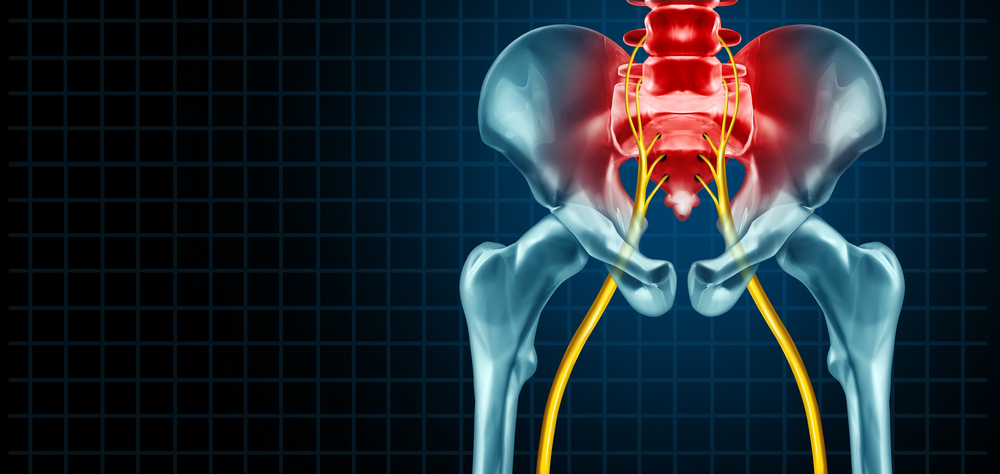
Sciatica refers to pain, numbness, weakness or tingling along the path of the sciatic nerve, a large nerve running from the lower back down the back of each leg. Anything causing inflammation, irritation or compression of this nerve or its roots can trigger sciatica symptoms.
Anatomy and Function of the Sciatic Nerve
The sciatic nerve is the largest and longest nerve in the human body, up to 2 cm wide in some people. It is actually a bundle of smaller nerve roots stemming from the lower spinal cord, specifically nerve roots L4 through S3.
The sciatic nerve originates in the lower back, exits the spinal column through an opening called the sciatic foramen and travels down the back of each leg through the buttocks and upper thigh. Along its course, it supplies nerve signals to the hamstring and calf muscles and also provides sensation to much of the lower limbs.
Damage or compression anywhere along the path of the sciatic nerve can result in the characteristic pain, numbness or tingling known as sciatica. Two main mechanisms are often at play – direct pressure on the nerve and inflammation around it.
Signs and Symptoms
Since sciatica involves irritation of this long nerve pathway, patients experience pain or unusual sensations anywhere along its course. Typical symptoms include:
Pain
Most often, sciatica manifests as pain in the low back, buttocks, rear thigh or radiating down one leg. It is generally one-sided, reflecting inflammation affecting either the right or left sciatic nerve specifically. The quality of pain can vary from an achy soreness to sharp, burning or electric shock-like. Pain levels fluctuate but tend to worsen with activities like bending, prolonged sitting or walking. Coughing or bowel movements may also intensify the discomfort.
Numbness and Tingling Sensations
Many patients describe sciatic nerve irritation as tingling pins-and-needles or numbness along the back of the leg or bottom of the foot – areas served by sciatic nerve branches. These odd paresthesia happen because inflammation and swelling make it harder for signals to travel along the nerve to the brain.
Muscle Weakness
In some cases, sciatica progresses to cause weakness or difficulty moving the affected leg or ankle/foot. This reflects impaired signaling from spinal nerves to the muscles they enervate. The foot may drag or slap the ground while walking due to ankle dorsiflexion issues. Hopping on one foot on the affected side may be challenging.
Reflex Changes
During the physical exam, your health provider may check reflexes like the knee-jerk response using a rubber hammer along the tendons. Diminished or absent reflexes indicate compromised signaling along the sciatic pathway.
Bowel or bladder incontinence, while very rare, would indicate severe sciatic nerve dysfunction worthy of prompt medical treatment.
Causes of Sciatica
Sciatica happens because something inflames, irritates or compresses the sciatic nerve roots or main nerve trunks. Several spinal causes can be at play:
Herniated/bulging discs – Leaking disc material in the lumbar spine can directly contact and irritate adjacent nerve roots. Also causes inflammation.
Spinal arthritis/bone spurs – Degenerative bony overgrowth narrowing spinal canals pinch nearby nerves.
Spondylolisthesis – Vertebral misalignment leads to nerve impingement.
Soft tissue tension – Tight piriformis or hamstring muscles can sometimes trap nerves.
Injuries – Falls, accidents, sports collisions or poor lifting mechanics can strain tissues around nerves.
Mass lesions like abscesses, hematomas or tumors can compress nerves in rare cases.
Lumbar spinal stenosis – When bony canals narrow, nerves get squeezed.
Identifying any structural issue sitting behind sciatic inflammation allows for specific management. But even without a clear mechanical cause, symptoms often settle over time.
Diagnosis
Since there are many potential causes of sciatic pain, a detailed history and physical examination are key first steps.
Your physician will ask about your symptoms, any trauma/injuries, pain triggers and relievers. They will also examine your spine, perform a straight leg raise test, assess reflexes and check for sensation/weakness along your legs.
Sometimes imaging tests are obtained to identify any structural issues:
- X-rays can detect fractures or bone issues.
- MRI gives a detailed view of spinal discs, nerves and soft tissues. It is usually the preferred test.
- CT scanning also creates cross-sectional images of bony structures.
Bloodwork or more specialized tests may be considered if an inflammatory condition or mass lesion is suspected behind your sciatica.
Sciatica describes nerve-related pain, numbness or weakness along the large sciatic nerve track. It develops from spinal nerve irritation, most often tracing to a lower back disc issue. Knowing the classic symptoms leads to earlier diagnosis and management. Stay tuned for an upcoming blog focusing on treatment approaches.
Written by Dr. Tony Mork
Orthopedic Spine Surgeon
I’m Dr. Tony Mork, MD, a Minimally Invasive Orthopedic Spine Surgery Specialist in Newport Beach, California. With over 40 years of experience, I’m dedicated to providing information for all topics that involve neck and back pain.
February 1, 2024
Contact a Spine Specialist Near You!
Related Articles
Lower Back Pain | An Overview
Lower back pain is an exceedingly common affliction that affects up to 80% of adults at some point in their lives. Understanding the underlying causes of lower back pain is key to finding the appropriate treatment and relief. Anatomy of the Lower Back The lower back,...
Degenerative Disc Disease | Causes and Risk Factors
Degenerative disc disease describes age-related wear and tear to the rubbery spinal discs cushioning the vertebrae that can lead to chronic back or neck pain. While partly genetic, there are also lifestyle factors and injuries that accelerate disc degeneration over...
Upper (Thoracic) Back Pain | What is Causing My Pain?
Upper back pain is a surprisingly common affliction, affecting up to one-quarter of the adult population at some point. While not as prevalent as lower back pain, discomfort in the thoracic region still accounts for a substantial slice of musculoskeletal complaints...



